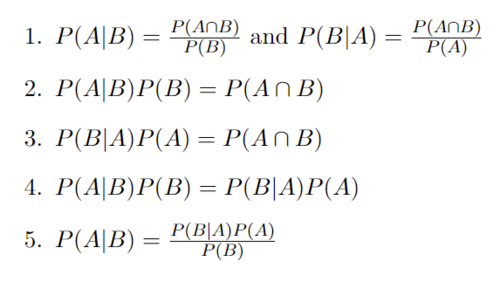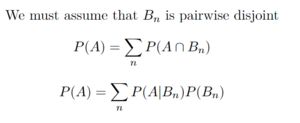| Line 40: | Line 40: | ||
Baye's Theorem Derivation: | Baye's Theorem Derivation: | ||
Starting with the definition of Conditional Probability | Starting with the definition of Conditional Probability | ||
| + | |||
[[File:Bayes derivation.png|500px|]] | [[File:Bayes derivation.png|500px|]] | ||
| + | |||
In Step 1 with the definition of conditional probabilities, it is assumed that P(A) and P(B) are not 0. | In Step 1 with the definition of conditional probabilities, it is assumed that P(A) and P(B) are not 0. | ||
Revision as of 10:31, 15 November 2022
Probability : Group 4
Kalpit Patel Rick Jiang Bowen Wang Kyle Arrowood
This is an edit
Probability, Conditional Probability, Bayes Theorem Disease example
Definition: Probability is a measure of the likelihood of an event to occur. Many events cannot be predicted with total certainty. We can predict only the chance of an event to occur i.e., how likely they are going to happen, using it. Probability can range from 0 to 1, where 0 means the event to be an impossible one and 1 indicates a certain event. The probability of all the events in a sample space adds up to 1.
Notation:
1) Sample space (S): Set of all possible outcomes of an experiment (e.g., S={O1,O2,..,On}).
2) Event: Any subsets of outcomes (e.g., A={O1,O2,Ok}) contained in the sample space S.
Formula for probability:
1. Let N:= |S| be the size of sample space
2. Let N(A):= |A| be the number of simple outcomes contained in event A
3. Then P(A) = N(A)/N
Axioms of probability
Baye's Theorem Derivation: Starting with the definition of Conditional Probability
In Step 1 with the definition of conditional probabilities, it is assumed that P(A) and P(B) are not 0.
In Step 2 we multiply both sides by P(B) and in step 3 we multiply both sides by P(A) and we end up with the same result on the right hand side of each.
In Step 4 we are able to set both left sides equal to each other since they both have the same right hand side.
In Step 5 we divide both sides by P(B) and we arrive at Baye's Theorem.
It is also important to introduce the law of total probability:
The law of total probability is commonly used in Baye's rule examples in order to calculate the denominator. A quick example using the law of total probability is:
In this example we are able to solve for the probability of A by just using the probability of A given B, the probability of A given the complement of B, and the probability of B.




